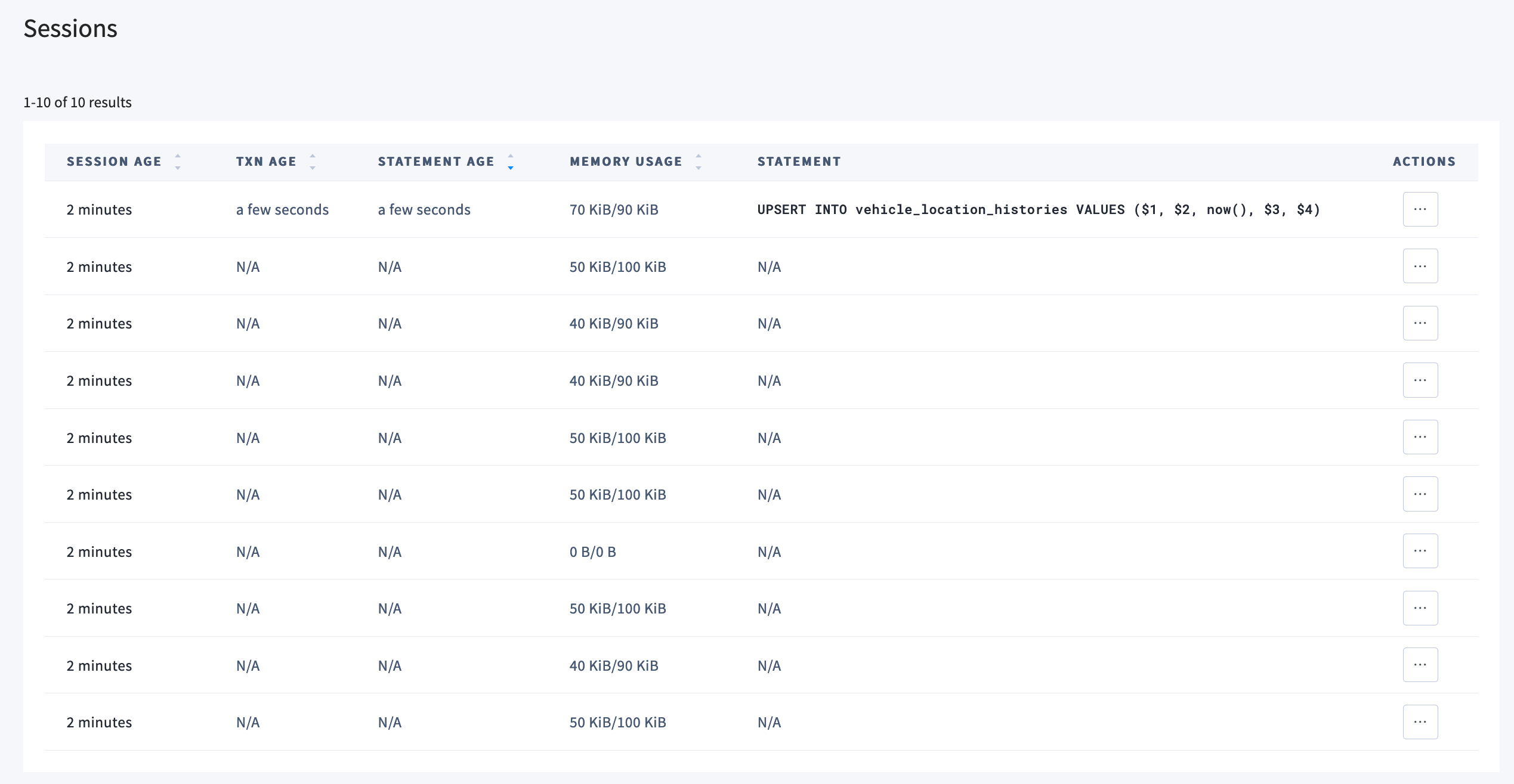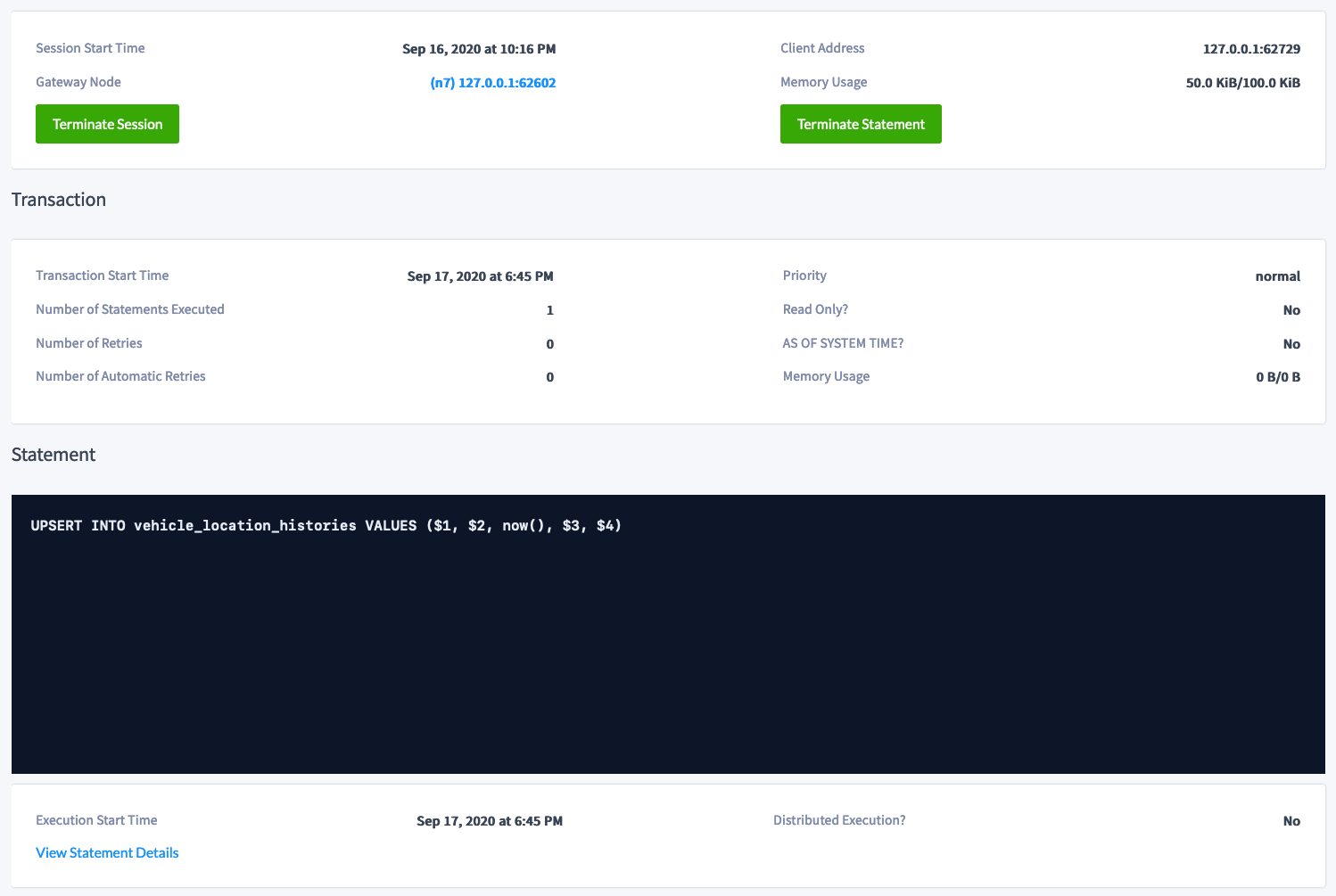
On a secure cluster, this area of the DB Console can only be accessed by a SQL user with the VIEWACTIVITY role option. Note that non-admin users will see only their own sessions, while admin users see sessions for all users.
New in v20.2: The Sessions page of the DB Console provides details of all open sessions in the cluster.
To view this page, access the DB Console and click Sessions in the left-hand navigation.
Sessions list
Use the Sessions list to see the open sessions in the cluster. This includes active and idle sessions.
A session is active if it has an open transaction (including implicit transactions, which are individual SQL statements), and idle if it has no open transaction. Active sessions consume hardware resources.
- If a session is active, the most recent SQL statement is displayed in the Statement column.
- If a session is idle, Transaction Duration, Statement Duration, and Statement will display
N/A. - To view details of a session, click the Session Duration.
An active session can have an open transaction that is not currently running SQL. In this case, the Statement and Statement Duration columns will display N/A and Transaction Duration will display a value. Transactions that are held open can cause contention.

The following are displayed for each active session:
| Parameter | Description |
|---|---|
| Session Age | Amount of time the session has been open. |
| Txn Duration | Amount of time the transaction has been active, if there is an open transaction. |
| Statement Age | Amount of time the SQL statement has been active, if there is an active statement. |
| Memory Usage | Amount of memory currently allocated to this session / maximum amount of memory this session has ever been allocated. |
| Statement | Active SQL statement. If more than one statement is active, the most recent statement is shown. |
| Actions | Options to terminate the active query and/or terminate the session. These require the CANCELQUERY role option.Terminate Statement: Ends the SQL statement. The session running this statement will receive an error. Terminate Session: Ends the session. The client that holds this session will receive a "connection terminated" event. |
Sort by Txn Duration to display all active sessions at the top.
Session details
Click the Session Age of any session to display details and possible actions for that session.

- Session shows the ID of the connected session.
- Session Start Time shows the timestamp at which the session started.
- Gateway Node shows the node ID and IP address/port of the gateway node handling the client connection.
- Client Address shows the IP address/port of the client that opened the session.
- Memory Usage shows the amount of memory currently allocated to this session / maximum amount of memory this session has ever allocated.
- The Terminate Session button ends the session. The client that holds this session will receive a "connection terminated" event.
- The Terminate Statement button ends the SQL statement. The session running this statement will receive an error.
- Transaction will display the following information for an open transaction.
- Transaction Start Time shows the timestamp at which the transaction started.
- Number of Statements Executed shows the total number of SQL statements executed by the transaction.
- Number of Retries shows the total number of retries for the transaction.
- Number of Automatic Retries shows the total number of automatic retries run by CockroachDB for the transaction.
- Priority shows the priority for the transaction.
- Read Only? shows whether the transaction is read-only.
- AS OF SYSTEM TIME? shows whether the transaction uses
AS OF SYSTEM TIMEto return historical data. - Memory Usage shows the amount of memory currently allocated to this transaction / maximum amount of memory this transaction has ever allocated.
- Statement will display the following information for an active statement.
- The SQL statement is shown.
- Execution Start Time shows the timestamp at which the statement was run.
- Distributed Execution? shows whether the statement uses Distributed SQL (DistSQL) optimization.
- View Statement Details opens the Statement Details page for the statement.